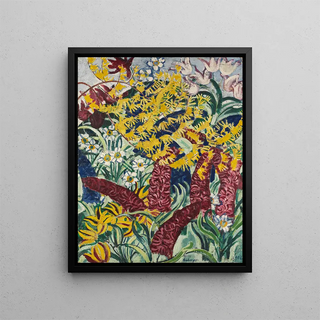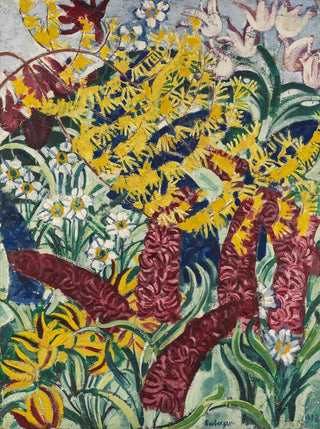Garden Flowers Painting I - August Babberger | Art print


View from behind

Frame (optional)
In the rich and colorful universe of floral art, "Fleurs de jardin I" by August Babberger stands out for its brilliance and delicacy. This piece, which evokes the ephemeral beauty of gardens, transports us to a world where nature expresses itself with rare intensity. The artist, through his brushstrokes, manages to capture the very essence of flowers, revealing their fragility while celebrating their splendor. The art print of this iconic work allows us to appreciate not only Babberger's mastered technique but also the emotion emanating from each petal and every shade of color. This painting is much more than a simple representation; it is an invitation to contemplate and feel the beauty of the natural world.
Style and uniqueness of the work
Babberger's style is characterized by a blend of realism and impressionism, where light plays a crucial role. In "Fleurs de jardin I," vibrant colors intertwine, creating a visual harmony that captures the eye and the mind. Each flower is rendered with precision that allows for appreciation of the details, while maintaining a certain fluidity reminiscent of a breeze in the garden. The composition of the piece, although centered on the flowers, also hints at the natural context surrounding them, thus strengthening the connection between art and nature. Babberger succeeds in evoking an atmosphere of serenity and timeless beauty, inviting the viewer to immerse themselves in a suspended moment where time seems to stand still.
The artist and his influence
August Babberger, an emblematic figure of floral art, knew how to mark his era with his unique vision and refined technique. Influenced by the great masters of painting, he developed a personal style that is his own, combining the rigor of drawing with the freedom of color. His works, often imbued with poetry, testify to a particular sensitivity towards nature and its wonders. Babberger also played a significant role in the artistic movement of his time, inspiring many artists to explore floral themes. His legacy endures, and "Fleurs de jardin I" is

Matte finish

View from behind

Frame (optional)
In the rich and colorful universe of floral art, "Fleurs de jardin I" by August Babberger stands out for its brilliance and delicacy. This piece, which evokes the ephemeral beauty of gardens, transports us to a world where nature expresses itself with rare intensity. The artist, through his brushstrokes, manages to capture the very essence of flowers, revealing their fragility while celebrating their splendor. The art print of this iconic work allows us to appreciate not only Babberger's mastered technique but also the emotion emanating from each petal and every shade of color. This painting is much more than a simple representation; it is an invitation to contemplate and feel the beauty of the natural world.
Style and uniqueness of the work
Babberger's style is characterized by a blend of realism and impressionism, where light plays a crucial role. In "Fleurs de jardin I," vibrant colors intertwine, creating a visual harmony that captures the eye and the mind. Each flower is rendered with precision that allows for appreciation of the details, while maintaining a certain fluidity reminiscent of a breeze in the garden. The composition of the piece, although centered on the flowers, also hints at the natural context surrounding them, thus strengthening the connection between art and nature. Babberger succeeds in evoking an atmosphere of serenity and timeless beauty, inviting the viewer to immerse themselves in a suspended moment where time seems to stand still.
The artist and his influence
August Babberger, an emblematic figure of floral art, knew how to mark his era with his unique vision and refined technique. Influenced by the great masters of painting, he developed a personal style that is his own, combining the rigor of drawing with the freedom of color. His works, often imbued with poetry, testify to a particular sensitivity towards nature and its wonders. Babberger also played a significant role in the artistic movement of his time, inspiring many artists to explore floral themes. His legacy endures, and "Fleurs de jardin I" is
12,34 €






